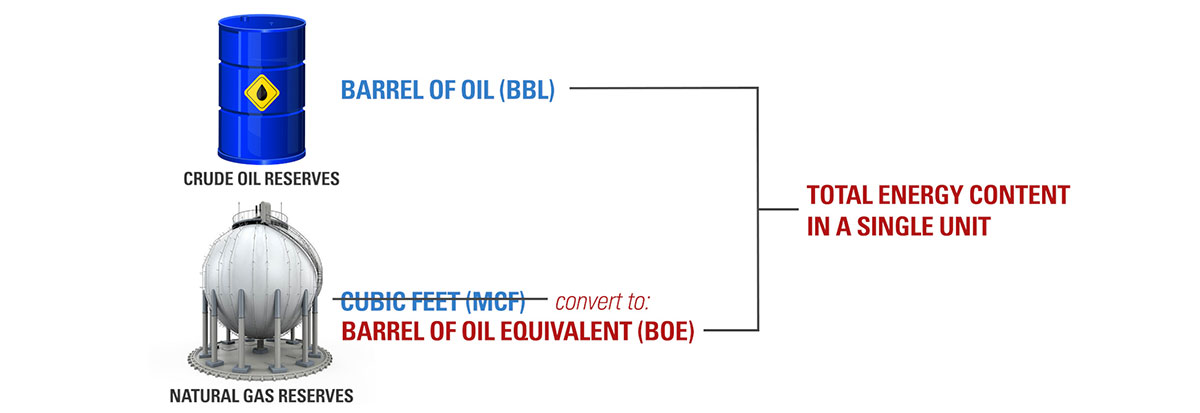Oil and gas companies and market publications use several abbreviations for produced resources, including BBL, BOE, BTU and MCF. In this article, we’ll define some of the most common abbreviations and their volume prefixes.
BBL = Barrel of Crude Oil
The abbreviation BBL stands for a barrel of crude oil. In the oil industry, an oil barrel is 42 US gallons.

Some sources say this abbreviation originated with Standard Oil Co. — the first oil giant in the United States, founded in 1870 by John D. Rockefeller.
Why the extra "B"?
Standard Oil used blue barrels to store and transport oil, thus most believe BBL originated as a symbol for “blue barrel”.
However, some sources believe the additional "b" in BBL may have simply been doubled to indicate the plural, such as 2 BBL.
BBL/D = Barrels of Crude Oil per Day
To measure oil production, you may see many different abbreviations (BPD, BOPD, BBL/D, BPD, BP, or B/D) which all represent “barrels of oil per day."
GPM = Gallons per Minute = GPM
Barrels per day may also need to be converted to a different scale of gallons per minute or GPM. This is a fluid flow rate of production rather than a measure of volume like BBL. This measurement is just as common but looks at production differently depending on what you need to learn from the information.
GPM = Gallons per Mcf
However, the acronym GPM is also a measurement for natural gas meaning gallons per Mcf, or gallons of NGLs produced per thousand cubic feet of gas processed. It’s a means for measuring the difference between lean and rich gas – as measured by the BTU of the gas and its GPM. The richer your gas, the more gallons you get.

MBBL and MMBBL = Thousand and Million Barrels of Oil
The number for barrels of oil per day can refer to anything from a global amount produced to a single production field so the numbers can vary wildly.
In the oil and gas industry, the prefix “M” stands for “one thousand.” Thus, “MM” is “M multiplied by M,” or one million.
You’ll commonly see barrels per day written as Mbbl (thousand barrels of oil) or MMbbl (million barrels of oil).
MCF = Thousand Cubic Feet of Natural Gas
Cubic feet is the measurement of volume used for natural gas.
MCF stands for 1,000 cubic feet of natural gas (1 MCF). Total gas reserve volumes are not typically in thousands of cubic feet, but rather in millions (MMCF), billions (BCF), and trillions (TCF).

CFM = Cubic Feet per Minute
CFM is cubic feet per minute. It is the measurement of the rate of flow for natural gas and is written as per day (CFD) or per minute (CFM).
Again, the prefix M (MCFD or MCFM) is one thousand and MM (MMCFD or NNCFM) is one million cubic feet per day.

BTU = British Thermal Unit
BTU is a unit of heat which stands for “British Thermal Unit.” BTU is the amount of heat needed to raise the temperature of one pound of water one degree Fahrenheit under standard conditions of pressure and temperature.

Simply put for our industry, BTU is a measure of the energy content of a fuel, in this case, natural gas.
There is no universal conversion for energy to volume because the energy content varies with the natural gas composition. As an approximation, 1,000 cubic feet of natural gas yields about 1,000,000 BTU when burned.
The price of natural gas is often expressed in currency units per energy content. For example, US dollars per million BTU (USD per MMBtu or ~1,000 cubic feet of natural gas).
BOE = Barrel of Oil Equivalent
The abbreviation BOE stands for “barrel of oil equivalent.” It is a unit of energy that combines different types of energy resources, like oil and natural gas, into a single figure to more easily represent the total amount of energy that a company can access.
Crude oil reserves are measured in barrels (BBL) and natural gas is measured in cubic feet (mcf). Converting these reserves to a barrel of oil equivalent, or BOE, gives a total energy content in a single unit. Now natural gas and other energy resources can be equally compared to the energy from one barrel of oil.

BOE is mostly used by exploration and production companies when reporting their total amount of reserves. It communicates to investors the total energy content that company can access.
Here’s an example of this unit of energy measurement:
6 MCF = 1 BOE
1,000 cubic feet of natural gas (1 MCF) contains about 1/6 of the energy content of a single barrel of oil. Therefore 6 MCF (6,000 cubic feet of natural gas) equals 1 BOE. That quantity of natural gas is “equivalent” to one barrel of oil.
BOE/D = Barrel of Oil Equivalent per Day
Daily energy production and consumption is expressed in barrels of oil equivalent per day or BOE/D. This unit is important to the financial community because it is a way to help evaluate the performance of energy companies.
Just as with barrels per day, you’ll commonly see MBOE (thousand barrel of oil equivalent) and MMBOE (million barrel of oil equivalent).
Relating this back to BTU, in the US, 1 BOE is equal to 5.8 million BTU.








































